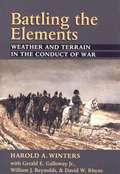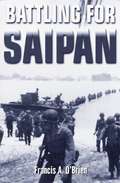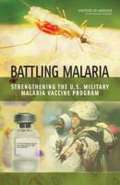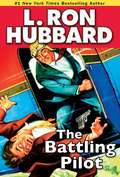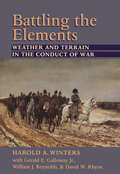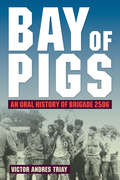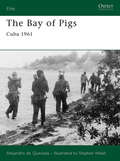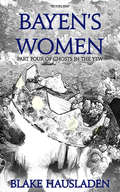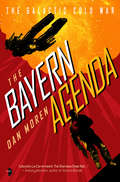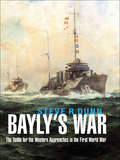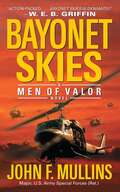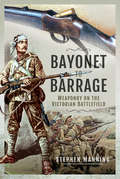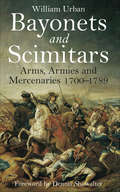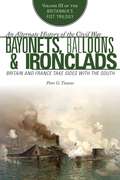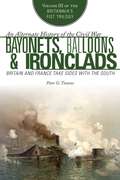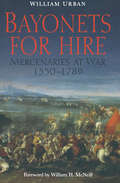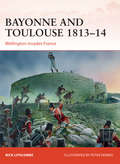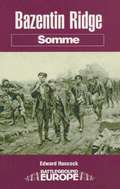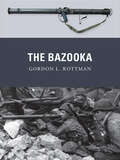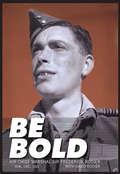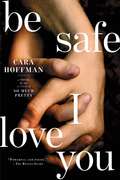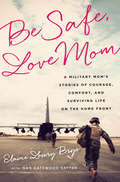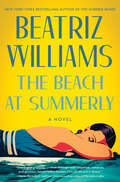- Table View
- List View
Battling The Elements: Weather And Terrain In The Conduct Of War
by Harold A. Winters Gerald Galloway William J. Reynolds David W. RhyneThroughout history, from Kublai Khan's attempted invasions of Japan to Rommel's desert warfare, military operations have succeeded or failed on the ability of commanders to incorporate environmental conditions into their tactics. In Battling the Elements, geographer Harold A. Winters and former U. S. Army officers Gerald E. Galloway Jr. , William J. Reynolds, and David W. Rhyne, examine the connections between major battles in world history and their geographic components, revealing what role factors such as weather, climate, terrain, soil, and vegetation have played in combat. Each chapter offers a detailed and engaging explanation of a specific environmental factor and then looks at several battles that highlight its effects on military operations. As this cogent analysis of geography and war makes clear, those who know more about the shape, nature, and variability of battleground conditions will always have a better understanding of the nature of combat and at least one significant advantage over a less knowledgeable enemy.
Battling For Saipan
by Francis A. O'BrienWhen Lt. Gen. Holland M. "Howlin' Mad" Smith and his V Amphibious Corps were preparing for the invasion of the Marianas -- Guam, Tinian, and Saipan -- they were expecting an easy fight. The Japanese appeared to be on the run. As D day for Saipan, the first of the three islands scheduled for conquest, loomed, V Corps operational planners felt safe in allocating a single division to serve as reserve for all three invasions. The initial landings of the 2d and 4th Marine Divisions ran into fierce opposition, however, forcing General Smith to commit the army's 27th Infantry Division (the entire corps's reserve starting) that first night. Among the soldiers landing on Saipan was Lt. Col. William O'Brien. The exploits of O'Brien and his battalion were amazing, including the award of the Medal of Honor to battalion commander O'Brien.
Battling Malaria: Strengthening The U.s. Military Malaria Vaccine Program
by Institute of Medicine of the National AcademiesThe National Academies Press (NAP)--publisher for the National Academies--publishes more than 200 books a year offering the most authoritative views, definitive information, and groundbreaking recommendations on a wide range of topics in science, engineering, and health. Our books are unique in that they are authored by the nation's leading experts in every scientific field.
Battling Pilot, the
by L. Ron HubbardRiveting, historical accounts of daredevils, pilots and brutal madmen that inspire many of today's cinematic blockbusters. Pilot Peter England's humdrum airplane routine is unexpectedly disrupted when his company reassigns him to transport some special passengers. But when his aircraft gets attacked by a mysterious fighter plane, Peter realizes he's transporting dangerous cargo--a princess seeking to turn the tide of a war! "...these programs burst to life..." Library Journal
Battling the Elements: Weather and Terrain in the Conduct of War
by Harold A. WintersThroughout history, from Kublai Khan's attempted invasions of Japan to Rommel's desert warfare, military operations have succeeded or failed on the ability of commanders to incorporate environmental conditions into their tactics. In Battling the Elements, geographer Harold A. Winters and former U.S. Army officers Gerald E. Galloway Jr., William J. Reynolds, and David W. Rhyne, examine the connections between major battles in world history and their geographic components, revealing what role factors such as weather, climate, terrain, soil, and vegetation have played in combat. Each chapter offers a detailed and engaging explanation of a specific environmental factor and then looks at several battles that highlight its effects on military operations. As this cogent analysis of geography and war makes clear, those who know more about the shape, nature, and variability of battleground conditions will always have a better understanding of the nature of combat and at least one significant advantage over a less knowledgeable enemy.
Bay of Pigs: An Oral History of Brigade 2506
by Victor Andres TriayFlorida Historical Society Samuel Proctor Award <p><p> From the interviews: <p><p> "My [pregnant] wife once asked me, ‘How is it possible you are not thinking of your child?’ I told her, ‘It is precisely because of that child and the two others I have here that I am going. I plan to return to my fatherland, and I don’t want a Communist homeland.’"-- Jorge Marquet <p><p> "One of the sad things that has happened over this period in the history of Cuba is that historians have not given credit to the idealism of those who turned against the revolution. We were really full of good will and wanted to make Cuba better."--Eduardo Zayas-Bazán <p><p> "[A] feeling of duty to defend our faith was what motivated my husband . . . . What made me give my blessing to his activities were my own feelings of duty."-- Myrna Pardo Millán (widowed by the invasion) <p><p> This is the story of the Bay of Pigs invasion, told for the first time in the words of the idealistic participants who came together in April 1961 to overthrow Fidel Castro’s dictatorship. Most of the approximately 1,500 men of Brigade 2506 were captured by Castro’s forces in Cuban swamps and jailed until December 1962. About 114 died. <p><p> Combining oral history and traditional narrative form, Victor Triay tells us who individual members of the brigade were and what they fought for. As one veteran, only eighteen at the time of the invasion, recalls, “It was my turn to do something for Cuba. Probably the purest thing I have ever done in my life was to make the decision to go.” Triay describes the volunteers’ recruitment, training, combat experience, and the wretched months of their imprisonment. He also presents the women they left behind, including three who were widowed by the invasion. <p><p> Among the nearly 2 million people in the U.S. Cuban community today, the freedom fighters who made up Brigade 2506 have always been accorded the highest level of respect. Bay of Pigs tells the personal stories of the invasion in an account that restores the human dimension to a pivotal moment in the history of the Cold War.
The Bay of Pigs
by Stephen Walsh Alejandro QuesadaOsprey's examination of the events in the Bay of Pigs (1961) that led to the Cuban Missile Crisis (1962). In early 1961 President John F. Kennedy gave the go-ahead to an existing plan for Cuban exiles to return to overthrow Fidel Castro's communist regime. While the CIA helped in the planning stages, the attempt would not be assisted by any US armed forces. On the night of April 16, 1961, a force of 1,400 exiles, known as 2506 Brigade, landed at the Bay of Pigs on the south coast of Cuba, supported by a few World War II vintage aircraft flying from Nicaragua. While they succeeded in knocking out some of Castro's small air force on the ground, the remaining Cuban aircraft sank two of the exiles' support ships, and the beachhead became isolated. Fighting continued for three days before Castro's army overwhelmed the landing force. Most of the exiles were captured and suffered a harsh imprisonment before the US negotiated their release. This episode, followed by the installation of Soviet missiles in Cuba, led directly to the Cuban Missile Crisis of October 1962, and continues to affect US/Cuban diplomatic relations to this day. This book, written by the nephew of a surviving 2506 Brigade veteran, includes detailed color plates, unpublished photographs, and interviews with veterans.From the Trade Paperback edition.
Bayen's Women (Ghosts in the Yew #4)
by Blake Hausladen“The soldier, the drunk, the spoiled prince, and the woman he sent to be trained to service him, each of these main characters narrates the story, adding their own point of view and coloring the events of the tale in a way that is engaging and unique.” – Natasha, GoodreadsThis novella is part four of Ghosts in the Yew, also available as a collection.The capital takes notice of Enhedu and the depths of one man's magic are tested.“If you cross this bridge with us, what awaits you is pain. Some do not survive it, so the decision to bring you was not made lightly. We cannot help you, and once started, there is no turning back.”Love is worth fighting for in this epic fantasy surrounded by the mystery of old gods, blood magic, and statecraft. Ignited by redemption and conquest, this journey will test their struggles to survive and will put them at odds with their families, their nation, and the very powers that shaped the world. But, this story is bigger than these things.It’s bigger than all of us.You can read the trilogy in full volumes, or broken up into five novellas each.The Vestal Series1. Ghosts in the Yew Novella 1 - Beyond the Edge Novella 2 - Opposing Oaths Novella 3 - Reckless Borders Novella 4 - Bayen's Women Novella 5 - Falling Tides2. Native Silver Novella 1 - Sutler's Road Novella 2 - Forgotten Stairs Novella 3 - Thrall's Wine Novella 4 - Corsair Princess Novella 5 - Tanayon Born 3. The Vastness Novella 1 - Silent Rebellion Novella 2 - The River War Novella 3 - The Blinded Novella 4 - Crimson Valley Novella 5 - Singer's Reward"While Ghosts in the Yew is action filled and magical, Mr Hausladen has obviously done his research and brings his high-finance background to bear in developing a detailed and complex background that includes socio-economic underpinnings and drivers in a world that seems all too realistic." – RickM, Goodreads
The Bayern Agenda: Book One of the Galactic Cold War
by Dan MorenA new Cold War threatens the galaxy, in this fast-paced and wisecracking thriller of spies and subterfuge.Simon Kovalic, top intelligence operative for the Commonwealth of Independent Systems, is on the frontline of the burgeoning Cold War with the aggressive Illyrican Empire. He barely escapes his latest mission with a broken arm, and vital intel which points to the Empire cozying up to the Bayern Corporation: a planet-sized bank. There’s no time to waste, but with Kovalic out of action, his undercover team is handed over to his ex-wife, Lt Commander Natalie Taylor. When Kovalic’s boss is tipped off that the Imperium are ready and waiting, it’s up to the wounded spy to rescue his team and complete the mission before they’re all caught and executed.File Under: Science Fiction [ Friendly Faces | Traitor, Pilot, Banker, Spy | Embassy Games | Going in Hot ]
Bayly's War: The Battle for the Western Approaches in the First World War
by Steve R DunnBaylys War is the story of the Royal Navys Coast of Ireland Command (later named Western Approaches Command) during World War One.Britain was particularly vulnerable to the disruption of trade in the Western Approaches through which food and munitions (and later soldiers) from North America and the Caribbean and ores and raw materials from the Southern Americas, all passed on their way to Liverpool or the Channel ports and London. After the sinking of the Lusitania in May 1915 and the introduction of unrestricted submarine warfare by the Germans, Britain found herself engaged in a fight for survival as U-boats targeted all incoming trade in an attempt to drive her into submission. Britains naval forces, based in Queenstown on the southern Irish coast, fought a long and arduous battle to keep the seaways open, and it was only one they began to master after American naval forces joined in 1917.Vice-Admiral Sir Lewis Bayly was the man appointed to the Coast of Ireland Command. A fierce disciplinarian with a mania for efficiency, and thought by some of his colleagues to be more than a little mad, Bayly took the fight to the enemy. Utilising any vessel he could muster trawlers, tugs, yachts as well as the few naval craft at his disposal, he set out to hunt down the enemy submarines. The command also swept for mines, escorted merchantmen and fought endlessly against the harsh Atlantic weather. Relief came When America sent destroyers to Queenstown to serve under him, and Bayly, to the surprise of many, integrated the command into a homogenous fighting force.Along the way, the Command had to deal with the ambivalent attitude of the Irish population, the 1916 Easter Rising, the attempt to land arms on Irelands west coast and the resurgence of Irish nationalism in 1917.Baylys War is a vivid account of this vigorous defence of Britains trade and brings to life the U-boat battles, Q-ship actions, merchant ship sinkings and rescues as well as the tireless Bayly, the commander at the centre.
Bayonet Skies: Men of Valor (Men of Valor #3)
by Mullins John F.Special Forces veteran John F. Mullins delivers heart-pounding action under fire in his third Men of Valor novel. 1975: With the Vietnam War drawing to a close, Captain James Carmichael begins a new life far from the front lines, in Bad Tölz, Germany. Married to a beautiful Russian émigré and awaiting his first child, Carmichael should be content training the 10th Special Forces for a European conflict that will likely never come. But the peacetime army is unmanageable, plagued by drugs and misbehavior, and Carmichael hungers for something more. That appetite gets fed when he is asked to rescue a P.O.W. being held by the North Vietnamese. It's a deadly proposition with dangerous odds, to which his wife bitterly objects. But Carmichael must answer the call of loyalty and risk everything he has -- on one last mission to bring his men back alive.
Bayonet to Barrage: Weaponry on the Victorian Battlefield
by Stephen ManningHow advances in weapons technology transformed the British soldier’s experience of war during the nineteenth century.How did technical advances in weaponry alter the battlefield during the reign of Queen Victoria? In 1845, in the first Anglo-Sikh War, the outcome was decided by the bayonet; just over fifty years later, in the second Boer War, the combatants were many miles apart. How did this transformation come about, and what impact did it have on the experience of the soldiers of the period? Stephen Manning, in this meticulously researched and vividly written study, describes the developments in firepower and, using the first-hand accounts of the soldiers, shows how their perception of battle changed.Innovations like the percussion and breech-loading rifle influenced the fighting in the Crimean War of the 1850s and the colonial campaigns of the 1870s and 1880s, in particular in the Anglo-Zulu War and the wars in Egypt and Sudan. The machine gun was used to deadly effect at the Battle of Omdurman in 1898, and equally dramatic advances in artillery took warfare into a new era of tactics and organization.Stephen Manning’s work provides the reader with an accurate and fascinating insight into a key aspect of nineteenth-century military history.
Bayonets and Scimitars: Arms, Armies and Mercenaries 1700–1789
by William UrbanA look at the tumult and transformations in warfare during the eighteenth century—and the world-changing events that resulted. The eighteenth century in Europe was a period of significant economic, political, and technological upheaval—which led to the American and French revolutions, and ultimately paved the way for Europe&’s domination of much of the world during the nineteenth century. The wars and political maneuvering of Frederick the Great and Catherine the Great transformed Prussia and Russia into major players in European politics. France, then the richest nation in the West, survived losing successive wars, then bankrupted itself assisting the Americans in an unnecessary war of revenge. Britain became the model of economic and financial efficiency and made itself supreme in North America, the Caribbean, and in India, only to face such financial troubles that its leaders antagonized its colonial subjects in America. This engaging new book by an esteemed military historian traces the evolution of war-making throughout this turbulent period—the politics, the weaponry, the organization of armies, and the transformation of mercenaries into professionals. This illuminating and highly readable account concentrates not just on high politics and military strategy, but also on the everyday experiences of those involved, giving us a fascinating glimpse into the human drama of eighteenth-century warfare.
Bayonets, Balloons, and Ironclads
by Peter G. TsourasPeter G. Tsouras presents the third installment in his Britannia's Fist alternate history series. The winter of 1863 had rung down a white curtain on the desperate struggle for North America. The United States and Great Britain had fought each other to a bitter draw. On both sides of the Atlantic the forges of war glowed as they poured out the new technologies of war. British and French aid transformed the ragged Confederate armies and filled them with new confidence. Both sides strained to be ready for the coming campaign season. Both sides seek to anticipate each other. The British strike suddenly at Hooker's strung out army in winter quarters in upstate New York in a brutal swirling late battle across frozen fields and streams. Besieged Portland shudders relentless assault. The French attack Fort Hudson on the Mississippi. At Lincoln's direction, two great raids are launched at the United Kingdom itself as Russia enters the war on the side of the Union to raid the Irish Sea. These are only preliminaries to the great gathering of modernized armies and ironclad fleets and with them are deadly submersibles and balloons. Battle rages from Maine to northern Virginia and the Chesapeake Bay, down to steamy Louisiana. And far away across the sea Dublin stands siege as Russia cast eyes upon Constantinople. For Americans, blue and gray, Britons, Irish, Frenchmen, and Russians, the summer of 1864 is the crescendo battle of destinies and dreams.
Bayonets, Balloons & Ironclads: Britain and France Take Sides with the South (Britannia's First Trilogy #3)
by Peter G. TsourasThis fascinating third volume in the Britannia's Fist series will have you pondering how easily history could have been swayed differently.What if other countries had become involved in America’s Civil War? Historian Peter G. Tsouras presents the third installment in his Britannia’s Fist alternate history series. The winter of 1863 lowered a white curtain on the desperate struggle for North America. The United States and Great Britain fought each other to a bitter draw. On both sides of the Atlantic, the forges of battle glowed as they poured out new technologies of war. British and French aid transformed the ragged Confederate armies and filled them with new confidence. Both sides strained to be ready for the coming campaign season. Both sides seek to anticipate each other.The British strike suddenly at Hooker’s strung-out army in winter quarters in upstate New York in a brutal, swirling, late battle across frozen fields and streams. Besieged Portland shudders relentless assault. The French attack Fort Hudson on the Mississippi. At Lincoln’s direction, two great raids are launched at the United Kingdom itself as Russia enters the war on the side of the Union to raid the Irish Sea. These are only preliminaries to the great gathering of modernized armies and ironclad fleets, and with them are deadly submersibles and balloons.Battles rage from Maine to northern Virginia and the Chesapeake Bay, down to steamy Louisiana. And far away across the sea, Dublin stands siege as Russia simultaneously eyes Constantinople. For Americans (blue and gray), Britons, Irish, Frenchmen, and Russians, the summer of 1864 is the crescendo battle of destinies and dreams.Skyhorse Publishing, as well as our Arcade, Yucca, and Good Books imprints, are proud to publish a broad range of books for readers interested in fiction?novels, novellas, political and medical thrillers, comedy, satire, historical fiction, romance, erotic and love stories, mystery, classic literature, folklore and mythology, literary classics including Shakespeare, Dumas, Wilde, Cather, and much more. While not every title we publish becomes a New York Times bestseller or a national bestseller, we are committed to books on subjects that are sometimes overlooked and to authors whose work might not otherwise find a home.
Bayonets For Hire: The U.S. Artillery from the Civil War to the Spanish-American War, 1861–1898
by William UrbanFrom the Greek professional armies of Alexander, through the Hundred Years War, indeed, to today, mercenaries have been ever-present, their role constantly evolving. In this compelling new history William Urban takes up their captivating and turbulent story from 1550 to 1789: from the Wars of Religion to the eve of the French Revolution. William Urbans many works include the highly acclaimed The Teutonic Knights and Medieval Mercenaries. William McNeill is the author of The Rise of the West and is among the worlds most respected historians.
Bayonne and Toulouse 1813-14
by Nick LipscombeThe news of Wellington's momentous victory at Vitoria on 21 June 1813 reached London in early July. The celebration spawned an expectation of a rapid conclusion to events in the Peninsula. His Majesty's Government gave authority for Wellington to invade France and made noises and plans for the redeployment of the Peninsular Army in support of Russia and Prussia. Wellington, however, did not see things in quite the same way. His army was worn out and there remained sizeable French forces in Spain, so what followed had to be a carefully thought out and planned campaign.The invasion of France is a complicated aspect of the culmination of the War in Iberia: indeed many historians consider the invasion and subsequent operations in southern France as separate from the Peninsular War as a whole. The preliminaries include Wellington's need to capture Pamplona and San Sebastian prior to the invasion and Soult's attempts to relieve both garrisons resulting in the Battle of the Pyrenees (July-August) and San Marcial (late August) respectively.The invasion itself commenced with the daring Allied crossing of the Bidassoa estuary in early October 1813 and was followed by an operational pause prior to the Battle of Nivelle in November, another pause to re-group and the subsequent offensives on the River Nive and the Battle of St. Pierre. This phase, and ipso facto the invasion, was complete by mid December 1813. Finally, the subsequent operations, which commenced early in 1814, provided the aftermath to the invasion and the conclusion to the Peninsular War. These actions focus primarily on the investment of Bayonne and the pursuit of Soult's army east, and include the battles and engagements at Garris, Orthez, Aire, Tarbes and the final showdown at Toulouse in April 1814.
Bazentin Ridge: Somme (Battleground Europe)
by Edward HancockThe book covers in detail the attacks of 14–18 July 1916 against the Bazentin Woods and villages and beyond. Walks and tours of the surroundings areas are included with detailed action maps.
The Bazooka
by Gordon Rottman Johnny ShumateThe bazooka was the popular name given to the innovative US rocket-propelled, man-portable antitank weapon that saw widespread service with US and other forces from 1942 to the early 1980s and was described by Eisenhower as one of the four "Tools of Victory" - with the atom bomb, the Jeep, and the C-47 Skytrain transport aircraft - that won World War II for the Allies.Most belligerents entering World War II armed their infantry with bulky and ineffectual antitank rifles as their primary means of combating tanks, but US planners realized that what infantrymen needed was a relatively lightweight, man-portable antitank weapon that was simple to operate, accurate, and capable of knocking out the average tank at a reasonable range, while also being effective against fortified buildings, pillboxes, and personnel in the open. The bazooka combined a revolutionary new antitank rifle-grenade warhead, a much-modified British antiaircraft rocket motor, and a cobbled-together launcher tube and electrical firing system; its first test-firing astounded observers, and it was immediately adopted by the US armed forces.Although the bazooka and its ammunition suffered teething problems, US and other troops quickly found the bazooka was highly effective against an enormous variety of targets. The weapon was widely used in all theaters of war; bazookas were provided as on-vehicle equipment for some armored fighting vehicles, and were even mounted under the wings of Piper Cub spotter aircraft to mark targets for fighter-bombers, and in multiple mounts on patrol torpedo boats targeting Japanese shipping. The Germans captured bazookas in North Africa and rapidly developed their own version, the formidable Panzerschreck, while the Chinese and Japanese copied the bazooka's revolutionary design.The bazooka was not without its drawbacks, however. It was sensitive to extremes of temperature and moisture, while the large backblast and smoke trail gave away the position of the shooter, and bazooka fire teams often had to move out of cover to obtain a clear shot. Rapid improvements in German tank armor meant that in the European theater the bazooka came to be seen as a "last resort" rather than an offensive weapon. Even so, the bazooka continued to see widespread service in Korea, where the original 2.36in models were supplanted by the 3.5in "super bazooka," also issued to many NATO forces. In the early 1960s the 3.5in was replaced in US Army service by the 90mm M67 recoilless rifle and the 66mm M72 light antitank weapon (LAW), a single-shot rocket launcher similar to the bazooka. The US Marine Corps, though, retained the 3.5in as an assault weapon throughout the Vietnam era and into the early 1980s.Featuring specially drawn color artwork, this engaging study tells the story of the bazooka, which set the standard for future light antitank weapons and their ammunition, and was a key influence on antitank tactics and techniques in the postwar era.
The BBC German Service during the Second World War: Broadcasting to the Enemy (Palgrave Studies in the History of the Media)
by Vike Martina PlockThis book, part media history and part group biography, tells the story of the BBC’s attempts to reach out to listeners in Nazi Germany at a time when Anglo-German relations were particularly strained. Who were the individuals behind the microphone, whose names could only be mentioned in whispered conversations on the continent? Who wrote the satirical sketches that offered comic relief to housewives struggling to obtain enough food to feed their families? And who made decisions about programme delivery and staffing? Drawing extensively on previously unexamined archival material, The BBC German Service during the Second World War: Broadcasting to the Enemy sheds light on the complex, often difficult working arrangements at the wartime BBC where people from different nationalities and socio-political backgrounds collaborated and argued about the delivery of an effective propaganda programme that would assist the Allies in defeating the Nazis.
Be Bold
by Sir Frederick Rosier David Rosier&“A very valuable autobiography of a senior RAF officer . . . provides an excellent insight into life in the RAF in both war and peace.&” —From Balloons to Drones Towards the end of a long and distinguished career, Sir Fred Rosier was persuaded by his son David to write his autobiography. He did so and the result is an extremely engaging and enlightening account of his life to the end of the Second World War. Starting with his humble beginnings to his time as a prewar fighter pilot on 43 Squadron at Tangmere; seeing action in France with 229 Squadron where he was shot down and burnt; his return as CO of that squadron during the Battle of Britain; taking 229 to the Western Desert, becoming one of two Fighter Wing commanders there; and then being appointed Group Captain Ops in 84 Fighter Group for the invasion, on through Europe, to the demise of Germany. David Rosier and his mother then completed the story up to Sir Fred&’s final appointments in the RAF as the last C-in-C of Fighter Command in 1968 and Deputy C-in-C Allied Forces Central Europe in 1973. Sir Fred was an inveterate letter writer, extracts from many of which appear in the book, and with a superb collection of photographs, this long-overdue account will be welcomed by anyone interested in one of the RAF&’s major personalities.
Be Safe I Love You: A Novel
by Cara HoffmanLauren Clay has returned from a tour of duty in Iraq just in time to spend the holidays with her family. Before she enlisted, Lauren, a classically trained singer, and her brother Danny, a bright young boy obsessed with Arctic exploration, made the most of their modest circumstances, escaping into their imaginations and forming an indestructible bond. Joining the army allowed Lauren to continue to provide for her family, but it came at a great cost. When she arrives home unexpectedly, it's clear to everyone in their rural New York town that something is wrong. But her father is so happy to have her home that he ignores her odd behavior and the repeated phone calls from an army psychologist. He wants to give Lauren time and space to acclimate to civilian life. Things seem better when Lauren offers to take Danny on a trip to visit their mother upstate. Instead, she guides them into the glacial woods of Canada on a quest to visit the Jeanne d'Arc basin, the site of an oil field that has become her strange obsession. As they set up camp in an abandoned hunting lodge, Lauren believes she's teaching Danny survival skills for the day when she's no longer able to take care of him. But where does she think she's going, and what happened to her in Iraq that set her on this path? From a writer whom The New York Times Book Review says, "writes with a restraint that makes poetry of pain," Be Safe I Love You is a novel about war and homecoming, love and duty, and an impassioned look at the effects of war on women--as soldiers and caregivers, both at home and on the front lines.
Be Safe, Love Mom: A Military Mom's Stories of Courage, Comfort, and Surviving Life on the Home Front
by Elaine Lowry BryeWhen you enlist in the United States military, you don’t just sign up for duty; you also commit your loved ones to lives of service all their own. No one knows this better than Elaine Brye, an "Army brat” turned military wife and the mother of four officers--one each in the Army, Navy, Air Force, and Marine Corps. For more than a decade she’s endured countless teary goodbyes, empty chairs at Thanksgiving dinners, and sleepless hours waiting for phone calls in the night. She’s navigated the complicated tangle of emotions--pride, worry, fear, hope, and deep, enduring love--that are part and parcel of life as a military mother. In Be Safe, Love Mom Elaine braids together her own personal experiences with those of fellow parents she’s met along the way. She offers gentle guidance and hard-earned wisdom on topics ranging from that first anxious goodbye to surrendering all control of your child, from finding comfort in the support of the military community and the healing power of faith to coping with the enormous sacrifices life as a military mother requires. Readers looking for encouragement and hard-to-come-by information as they travel the challenging road of having a child in uniform will find Elaine a wise and trusted friend, and Be Safe, Love Mom an essential handbook to membership in a strong and special sisterhood.
The Beach at Summerly: A Novel
by Beatriz Williams"Grand and gripping...shot through with suspense, romance, and glorious, beach-laden locales. I could not put it down."--Marie Benedict, New York Times bestselling author of The Mitford AffairA ravishing summer read from New York Times bestseller Beatriz Williams, sweeping readers back to a mid-century New England rich with secrets and Cold War intrigue.June 1946. As the residents of Winthrop Island prepare for the first summer season after the sacrifice of war, a glamorous new figure moves into the guest cottage at Summerly, the idyllic seaside estate of the wealthy Peabody family. To Emilia Winthrop, daughter of Summerly’s year-round caretaker and a descendant of the island’s settlers, Olive Rainsford opens a window into a world of shining possibility. While Emilia spent the war years caring for her incapacitated mother, Olive traveled the world, married fascinating men, and involved herself in political causes. She’s also the beloved aunt of the two surviving Peabody sons, Amory and Shep, with whom Emilia has a tangled romantic history.As the summer wears on, Emilia develops a deep rapport with Olive, who urges her to leave the island for a life of adventure, while romance blossoms with the sturdy and honorable Shep. But the heady promise of Peabody patronage is blown apart by the arrival of Sumner Fox, an FBI agent who demands Emilia’s help to capture a Soviet agent who’s transmitting vital intelligence on the West’s atomic weapon program from somewhere inside the Summerly estate.April 1954. Eight years later, Summerly is boarded up and Emilia has rebuilt her shattered life as a professor at Wellesley College, when shocking news arrives from Washington—the traitor she helped convict is about to be swapped for an American spy imprisoned in the Soviet Union, but with a mysterious condition only Emilia can fulfill. A reluctant Emilia is summoned to CIA headquarters, where she’s forced to confront the harrowing consequences of her actions that fateful summer, and a choice that could destroy the Peabody family—and Emilia’s chance for redemption—all over again.
The Beach House Anthology
by Tmonique Stephens Lk Shaw Christa Ann Bria AragonLifelong friends take a vacation to Myrtle Beach, North Carolina as part of their annual get-together. While at the beach house, they find so much more than they expected. Love. And for some, a second chance.All four stories are BRAND new, never before published with strong military heroes and the women who dare to love them. A look inside…A Second Chance at Love by LK Shaw ~ Kyle Harper and Callie Foster, both suffering from a different kind of heartache, meet during a chance encounter. Sparks fly, but each has a past they’d like to forget. Can two broken hearts be healed after a lifetime of pain? Twice in a Lifetime by Tmonique Stephens ~ A few days at the beach with her wild girlfriends is exactly what Liana Walters needed. Sun, sand, a tan, and drinks with little umbrellas. No stress. No worries. No cheating boyfriend. No pending breakup. Just perfect weather and the ocean. She didn’t think she had to include no ex-husbands on the list. The Storm Within by Christa Ann ~ Trevor sees Skye and everything in him tells him she’s the one. Skye can’t get past the dog tags and doesn’t want to get involved with anyone in the military. Her heart overrides her brain and demands her to trust. Can they both overcome their issues to give this relationship a try? Will Trevor re-enlist or stay in? Can Skye return to work and trust Trevor? Who’s Lovin’ Who? by Bria Aragon ~ Journey Duval and Dondre Collins are reinventing their relationship as they attend separate reunions in Myrtle Beach. Sexy fun is interrupted by the one who turned their lives upside down in the first place: Kamryn Woods, their former love. Will her shocking news undermine everything, or can this fractured trio learn to live happily ever after?
